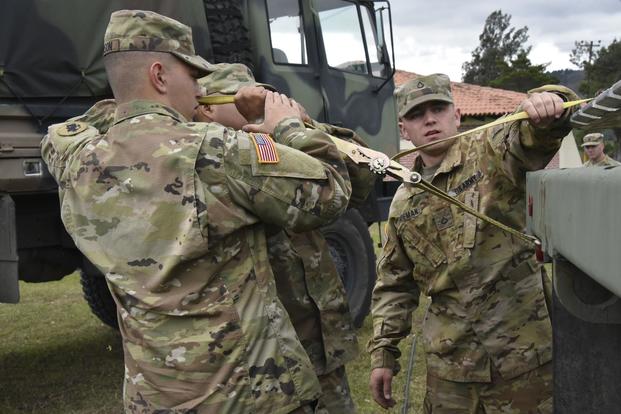Over the next few years, U.S. Army soldiers can expect to go on more training exercises designed to test a unit's ability to deploy with no notice and execute a decisive-action training mission.
The service's proposed fiscal 2019 budget, which was unveiled yesterday, features a $42 billion Operations and Maintenance account for the active force, compared to last year's request of $39 billion.
Part of the extra money will go toward prioritizing "rapid global response and force projection readiness." To accomplish this, Army training officials plan to conduct more Emergency Deployment Readiness Exercises, or EDREs, Brig. Gen. Mark Strong, director of readiness and mobilization for the Army's G3/5/7, told defense reporters today at the Pentagon.
During an EDRE, a unit is alerted with no-notice. Soldiers pack up their equipment and deploy to a location in Europe or the Asia-Pacific region to conduct one or more training missions, Strong said.
"In 2017, we did battalion-level EDRE exercises," Strong said. "First we took a fires battalion in the Asia-Pacific region for a full exercise that provided all those benefits to those soldiers -- no notice, pack out, move their equipment, be received, conduct training and live-fire and redeploy. We did the same thing in Europe. We took an infantry battalion for almost a month. We took them out of Fort Carson."
This is far different from what soldiers experienced preparing for deployments in Afghanistan or Iraq where active forces had, in some cases, up to 365 days to prepare. Soldiers in the Reserve component likely had up to two years of notification, Strong said.
"These EDREs are for core-mission, decisive-action readiness," Strong said. "It's a leader-development skill that you don't get by what we do with known rotations to the CentCom AOR."
The plan now is to enhance the EDRE program by exposing larger units to the experience.
"So what we want to do in 2018, 2019 and 2020 is elevate the amount of forces that can do that at echelon," Strong said. "You look at battalion, you look at brigade, you look at multiple brigades and eventually is there a larger package that may include a division-level headquarters doing those kinds of thing. There are substantial benefits tied to that."
Rapid deployment units in the Global Response Force, such as the 82nd Airborne Division, practice no-notice deployments with a goal of being ready to go in 18 hours or less.
"We are not talking about Global Response Force or very-early entry," he said. "Normally, we will see the initial flow of forces within 96 hours."
But that launch time will depend on how well units can coordinate transportation.
"One of the interesting things is we have to coordinate for our transportation," Strong said. "TransCom plays a role in availability of movement of the equipment by aircraft which kind of drives maybe whether this takes up two weeks to execute."
Units will still be expected to be ready to deploy as quickly as possible, Strong said.
"From notification, the unit goes from no knowledge to full-strength preparing themselves to get out the door," Strong said.
Matthew Cox can be reached at matthew.cox@military.com.













